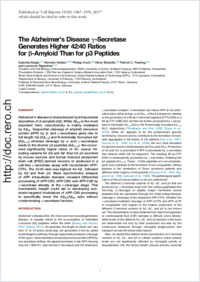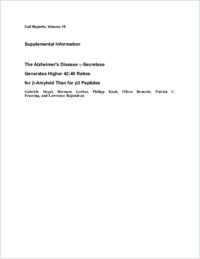The Alzheimer’s disease γ-secretase generates higher 42:40 ratios for β-amyloid than for p3 peptides
- Siegel, Gabriele Systems and Cell Biology of Neurodegeneration, IREM, University of Zurich, Schlieren Campus, 8952 Schlieren, Switzerland
- Gerber, Hermeto Foundation Eclosion, Plan-les-Ouates - Campus Biotech Innovation Park, Geneva, Switzerland - Brain Mind Institute and School of Life Sciences, Swiss Federal Institute of Technology (EPFL), Lausanne, Switzerland - Department of Biology, University of Fribourg, Switzerland
- Koch, Philipp Institute of Reconstructive Neurobiology, University of Bonn Medical Faculty, Germany - LIFE and BRAIN GmbH, Bonn, Germany
- Bruestle, Oliver Institute of Reconstructive Neurobiology, University of Bonn Medical Faculty, Germany - LIFE and BRAIN GmbH, Bonn, Germany
- Fraering, Patrick C. Foundation Eclosion, Plan-les-Ouates - Campus Biotech Innovation Park, Geneva, Switzerland - Brain Mind Institute and School of Life Sciences, Swiss Federal Institute of Technology (EPFL), Lausanne, Switzerland
- Rajendran, Lawrence Systems and Cell Biology of Neurodegeneration, IREM, University of Zurich, Schlieren Campus, 8952 Schlieren, Switzerland -
-
06.06.2017
Published in:
- Cell Reports. - 2017, vol. 19, no. 10, p. 1967–1976
Alzheimer’s diseaseamyloid precursor protein
beta-Amyloid
p3 peptidegamma-secretase
APP CTF
amyloidogenic pathway
AICD
primary neurons
iPS cells
English
Alzheimer’s disease is characterized by intracerebral deposition of β-amyloid (Aβ). While Aβ40 is the most abundant form, neurotoxicity is mainly mediated by Aβ42. Sequential cleavage of amyloid precursor protein (APP) by β- and γ-secretases gives rise to full-length Aβ (Aβ1-x) and N-terminally truncated Aβ′ (Aβ11-x) whereas cleavage by α- and γ-secretases leads to the shorter p3 peptides (Aβ17-x). We uncovered significantly higher ratios of 42- versus 40-ending variants for Aβ and Aβ′ than for p3 secreted by mouse neurons and human induced pluripotent stem cell (iPSC)-derived neurons or produced in a cell-free γ-secretase assay with recombinant APP-CTFs. The 42:40 ratio was highest for Aβ′, followed by Aβ and then p3. Mass spectrometry analysis of APP intracellular domains revealed differential processing of APP-C83, APP-C89, and APP-C99 by γ-secretase already at the ε-cleavage stage. This mechanistic insight could aid in developing substrate-targeted modulators of APP-C99 processing to specifically lower the Aβ42:Aβ40 ratio without compromising γ-secretase function.
- Faculty
- Faculté des sciences et de médecine
- Department
- Département de Biologie
- Language
-
- English
- Classification
- Biological sciences
- License
- License undefined
- Identifiers
-
- RERO DOC 305032
- DOI 10.1016/j.celrep.2017.05.034
- Persistent URL
- https://folia.unifr.ch/unifr/documents/305974
Other files
Statistics
Document views: 78
File downloads:
- ger_adg.pdf: 169
- ger_adg_sm.pdf: 111

